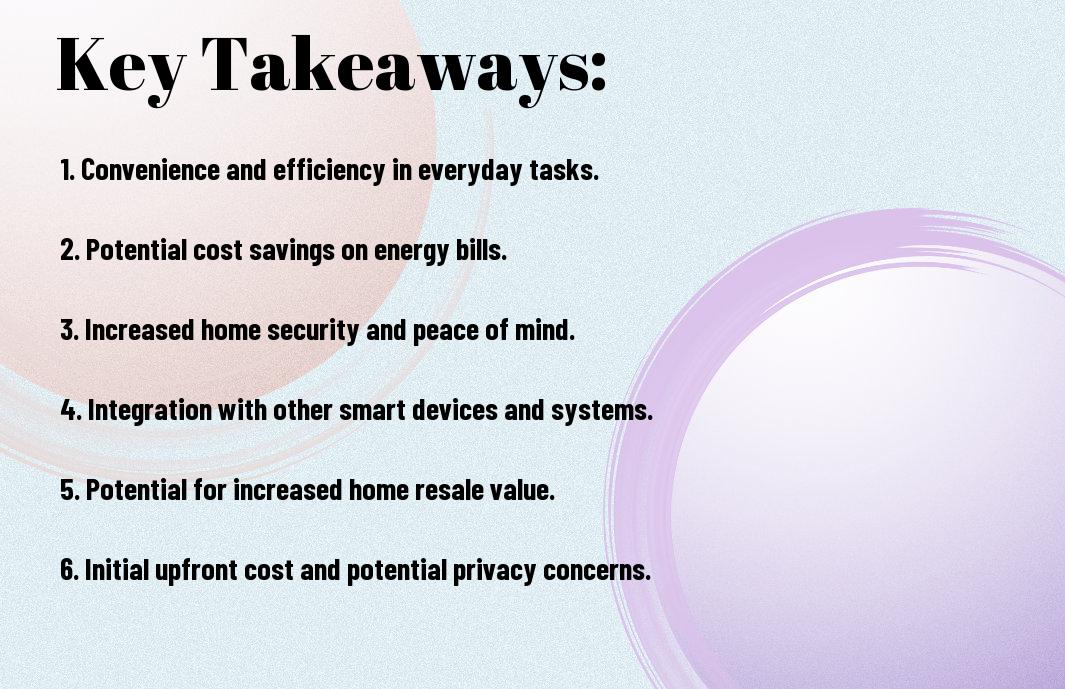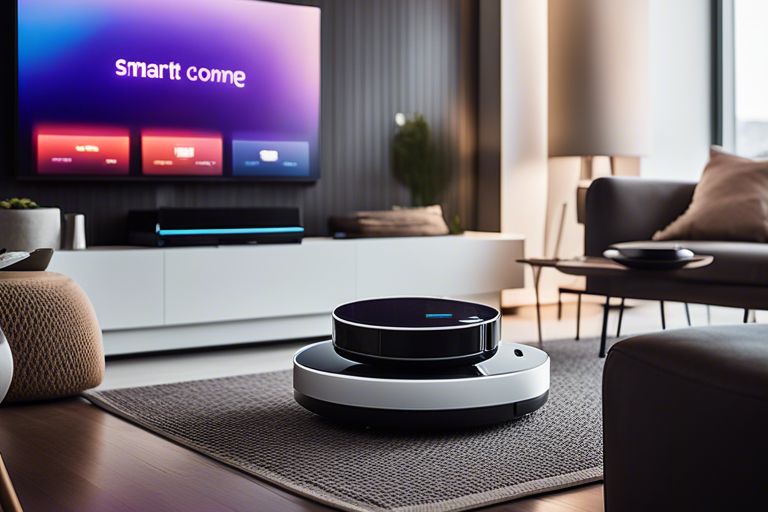Considering the rapid advancements in technology, you may be wondering whether investing in smart home gadgets is truly worth it. Smart home devices can certainly offer a range of convenient and time-saving benefits, such as remote access to your devices and the ability to automate household tasks. However, it’s important to weigh the potential downsides as well. Security and privacy risks are a major concern with these connected devices, as they can be vulnerable to hacking and data breaches. Moreover, the cost of purchasing and maintaining smart gadgets can add up quickly. In this blog post, we will explore the pros and cons of smart home gadgets to help you decide whether they are a worthwhile investment for you.
Key Takeaways:
- Convenience: Smart home gadgets can offer a high level of convenience by automating tasks and making daily routines easier.
- Cost Savings: While the initial investment may be high, smart home gadgets can lead to long-term cost savings through energy efficiency and reduced utility bills.
- Security: Many smart home gadgets offer improved security features, providing peace of mind for homeowners.
- Customisation: Smart home gadgets can be tailored to suit individual needs and preferences, providing a personalised experience for users.
- Future-Proofing: Investing in smart home technology can increase the value of a property and appeal to potential buyers in the future.
Assessing Smart Home Technology
When considering whether smart home gadgets are worth the investment, it’s essential to assess the technology that is available and determine how it can benefit your daily life. There are various aspects to consider, including the cost-benefit analysis of smart gadgets and the balance between long-term savings and upfront costs.
Cost-Benefit Analysis of Smart Gadgets
Before investing in smart home technology, it’s important to consider the cost-benefit analysis. While the initial cost of purchasing and installing smart gadgets may seem significant, the long-term benefits often outweigh the upfront investment. Smart home gadgets can improve energy efficiency, enhance security, and provide convenience in your daily life. Consider the potential savings on utility bills, the added security of remote monitoring, and the time saved on daily tasks. When making the cost-benefit analysis, it’s important to consider both the immediate and long-term value that smart gadgets can provide.
Long-Term Savings vs. Upfront Costs
When weighing the decision to invest in smart home technology, it’s crucial to balance the long-term savings with the upfront costs. While the initial investment may seem substantial, many smart gadgets offer the potential for significant long-term savings. For example, smart thermostats can optimise energy usage, resulting in lower heating and cooling costs over time. Similarly, smart lighting systems can reduce energy consumption and lower electricity bills. When considering the long-term savings vs. upfront costs, it’s essential to evaluate the potential financial benefits alongside the initial investment in smart home technology.
The Convenience Factor
When it comes to smart home gadgets, one of the primary reasons people invest in them is for the convenience they offer. From controlling your home’s temperature and lighting with a simple voice command to remotely monitoring your security cameras, these gadgets are designed to make your life easier.
Enhancing Daily Life with Automation
With the automation capabilities of smart home gadgets, you can save time and effort in your daily routine. Imagine waking up to the smell of brewed coffee as your smart coffee maker starts brewing, while your smart blinds open to let in the morning sunlight. You can also set schedules for your devices to turn on and off at specific times, ensuring that your home is always comfortable and secure, without you having to lift a finger.
Integration and Interoperability Challenges
However, one of the challenges you may encounter with smart home gadgets is the issue of integration and interoperability. Not all devices are compatible with each other, which can lead to a fragmented experience. For example, your smart speaker may not be able to control certain smart lights, or your smart thermostat may not communicate effectively with your smart home security system. This can lead to frustration and potential issues with the overall functionality of your smart home ecosystem.
“`
Security and Privacy Concerns
When it comes to smart home gadgets, security and privacy concerns are at the forefront of many people’s minds. With the increasing connectivity of devices, there is a potential for these gadgets to be vulnerable to hacking and other security breaches. It’s important to be aware of these risks and take steps to protect your smart home and personal information.
Protecting Your Smart Home
One of the most important steps you can take to protect your smart home is to ensure that all of your devices are secure. This means regularly updating their software and firmware to patch any potential vulnerabilities. You can also strengthen your home network security by using strong, unique passwords for each device and enabling two-factor authentication where possible. Investing in a reputable antivirus and security software can also help safeguard your smart home from cyber threats.
Understanding Data Risks
Another important aspect of smart home security is understanding the potential data risks. When you use smart home gadgets, they often collect and store a significant amount of data about your habits and routines. While this data can be used to enhance your user experience, it also poses a privacy risk if it falls into the wrong hands. It’s essential to review and understand the privacy policies of the gadgets you use, as well as the data they collect. By being aware of these risks, you can take steps to limit the data being collected and protect your privacy.
“`
Market Trends and Future Outlook
As the demand for smart home gadgets continues to rise, it is important to consider the market trends and future outlook for these technologies. Keeping an eye on the latest innovations and predicting the smart home landscape will help you make informed decisions about investing in these gadgets.
Innovations on the Horizon
With advancements in technology, innovations on the horizon for smart home gadgets include improved integration with voice assistants, more sophisticated security features, and greater energy efficiency. For example, you can expect to see more devices that can be controlled through voice commands, as well as enhanced security systems that offer real-time monitoring and alerts. Furthermore, the development of energy-efficient smart appliances will not only benefit the environment but also help you save on your utility bills.
Predicting the Smart Home Landscape
When predicting the smart home landscape, it is evident that the market is set to expand significantly. The integration of artificial intelligence and machine learning will lead to smarter, more intuitive devices that can anticipate your needs and adapt to your preferences. Additionally, the rise of interoperability standards will allow different smart home gadgets to seamlessly work together, creating a more cohesive and user-friendly experience for you.

Are Smart Home Gadgets Worth the Investment?
Upon reflecting on the question of whether smart home gadgets are worth the investment, it is clear that the answer depends on your individual needs and lifestyle. As discussed in the Forbes article “Ask The Contractor: Are Smart Devices Worth The Money?”, smart devices can certainly provide convenience, energy savings, and increased security for your home. However, it’s important to carefully consider the upfront costs and potential ongoing expenses, as well as the level of technical proficiency required to use and maintain these gadgets. Ultimately, the decision to invest in smart home gadgets should be based on your specific requirements and the long-term benefits they can offer to you and your household.
FAQ
Q: Are smart home gadgets worth the investment?
A: Smart home gadgets can definitely be worth the investment for those looking to enhance their home’s efficiency, security, and convenience.
Q: What are the main benefits of smart home gadgets?
A: Smart home gadgets can help save energy, improve home security, and provide convenience through automation and remote control.
Q: What types of smart home gadgets are available?
A: Smart home gadgets range from smart thermostats and lighting systems to security cameras and smart locks, and even smart kitchen appliances.
Q: How do smart home gadgets save energy?
A: Smart thermostats can learn your heating and cooling preferences and adjust accordingly, while smart lighting can be scheduled and dimmed to reduce energy consumption.
Q: Are smart home gadgets secure?
A: When properly set up and maintained, smart home gadgets can be secure. It’s important to use strong, unique passwords and keep software updated to prevent hacking or breaches.
Q: Do smart home gadgets require a lot of maintenance?
A: Smart home gadgets generally require minimal maintenance, but it’s important to keep software updated and occasionally troubleshoot any connectivity issues.
Q: Are smart home gadgets compatible with all homes?
A: While most smart home gadgets are designed to be compatible with a range of homes, it’s important to check for compatibility before making a purchase, especially for older homes or specific wiring setups.
